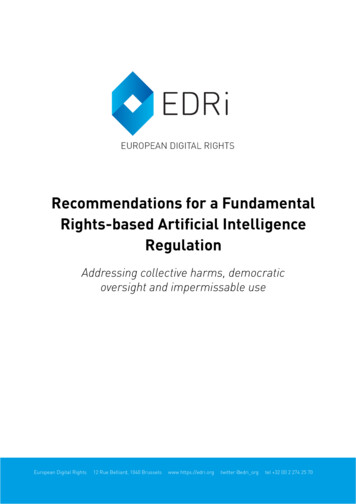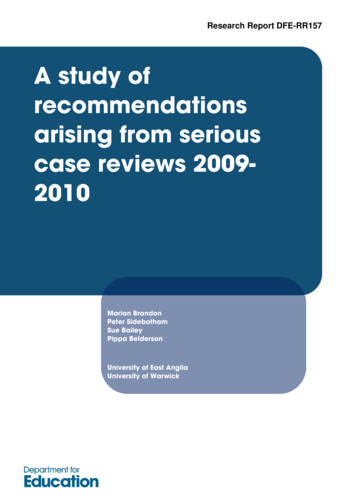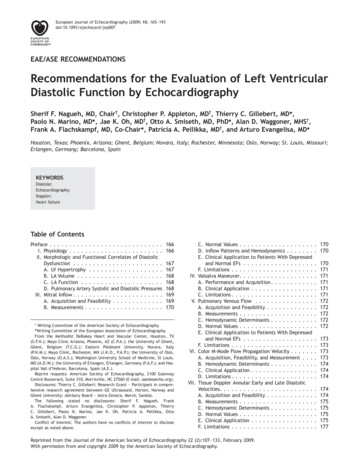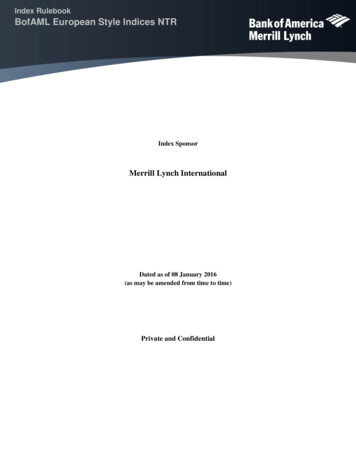
Transcription
Recommendations for a FundamentalRights-based Artificial IntelligenceRegulationAddressing collective harms, democraticoversight and impermissable useEuropean Digital Rights12 Rue Belliard, 1040 Brusselswww https://edri.orgtwitter @edri orgtel 32 (0) 2 274 25 701
Recommendations for a fundamentalrights-based artificial intelligence responseAddressing collective harms, democraticoversight and impermissable usePublished on 04 June 2020 in BrusselsLead author:Sarah Chander, EDRi Senior Policy AdvisorLayout by:Rafael Hernández, EDRi Communications InternThe EDRi Brussels office would like to express our enormous thanks the whole network for their time, advice, participation and support in producing this paper and tothe 28 organisations that particpated in the consultation. In particular, the followingorganisations and individuals have been instrumental across multiple stages of researching, drafting, discussing and reviewing:Access NowArticle 19Bits of FreedomDigitalcourage e.V.IT- Political Association of DenmarkHomo DigitalisPanoptykon FoundationPrivacy InternationalStatewatchVrijschrift2
Table of Contents1. Fundamental Rights Impacts of Artificial Intelligence.52. A rights-based approach: general principles.83. Recommendations for a fundamental rights-based AI regulation.94. Further resources.133
We are starting to see the impact of artificial intelligence in all areas of public life. Asgovernments, institutions and industry swiftly move to ‘innovate’ - promoting, investingand incorporating AI into their systems and decision-making processes - grave concerns remain as to how these changes will impact people, communities and societyas a whole. AI systems have the ability to exacerbate surveillance and intrusion into ourpersonal lives, reflect and reinforce some of the deepest societal inequalities, fundamentally alter the delivery of public and essential services, vastly undermine vital dataprotection legislation, and disrupt the democratic process itself.The growth of artificial intelligence is specific and warrants attention because - due tothe (designed) opacity of the systems, the complete lack of transparency from state andprivate actors when such systems are deployed for use in public, essential functions,and the systematic lack of democratic oversight and engagement – AI is furthering the‘power asymmetry between those who develop and employ AI technologies, and thosewho interact with and are subject to them.’1 For some, AI will mean reinforced, deeperharms as such systems feed and embed existing processes of marginalisation. For all,the route to remedies, accountability, and justice will be ever-more unclear, as this power asymmetry further shifts to private actors, and public goods and services will be notonly automated, but privately owned.The European Union’s upcoming legislative proposal on artificial intelligence (AI) is anopportunity to protect people, communities and society from the escalating economic,political and social issues, posed by AI. This paper outlines the position of European Digital Rights (EDRi) in response to the European Commission’s White Paper on ArtificialIntelligence.We argue that the European Union’s regulatory response must reinforce the protectonsalready embedded in the General Data Protection Regulation (GDPR), outline clearlegal limits for AI by focusing on impermissable use, and foreground principles of collective impact, democratic oversight, accountability, and fundamental rights.EDRi argues that regulation is necessary to guarantee fundamental rights in relation toArtificial Intelligence. Regulation is needed for two purposes:1. Defining the legal boundaries for AI – The EU must set legal boundaries whichreflect social and fundamental rights concerns in order to provide certainty as towhat AI may be developed and deployed, and for which purposes.2. Outling clear fundamental rights safeguards – within these boundaries, theremust be sufficient safeguards to protect fundamental rights in the procurement,design, development, deployment of all systems.1Council of Europe (2019). ‘Responsibility and AI DGI(2019)05 Rapporteur: Karen Yeung d9c54
Whilst the European Commission has made clear proposals for the latter, the WhitePaper proposal does not set adequate social, fundamental rights-based boundaries tounderpin its regulatory response to AI. The European Commission now has an opportunity to improve its regulatory proposal to ensure a ‘human-centred’ approach which trulypromotes ‘trustworthy AI’.This paper oulines the fundamental rights impacts of aritficial intelligence, making thecase for regulation on AI. Further, EDRi outlines general principles to inform the updated regulatory response, and lastly, recommendations for a fundamental rights-based AIregulation.1. Fundamental Rights Impacts of Artificial IntelligenceThe below outlines the main fundamental rights risks of AI underlying EDRi’s positionon the European Commission White Paper. AI will pose unprecedented challenges forfundamental rights in a number of areas – this must be addressed in AI regulation.Data-protection: Increased use of artificial intelligence pose inherent risks to existingdata protection rights and standards. More structurally, AI relies on the processing oflarge amounts of data for training and accuracy, raising major questions for consent andpersonal privacy as general principles. In addition, any regulation of AI must strengthen and complement the enforcement of the GDPR, addressing severe issues posed byAI for the enforcement of meaningful consent, objection, data minimisation, purposelimitation, explanation. Further, many uses of AI function through the use of non-personal data or sensitive inferences2 of personal information about individuals, thereforethreatening anonymity and the spirit of the rights enshrined in the GDPR. This poses achallenge for data protection rights and the regulation of AI.3Equality, non-discrimination and inequality: AI and other automated systems are likelyto worsen discrimination, due to greater scales of operation, increased unlikelihood thathumans will challenge its decisions (automation bias), and lower levels of transparencyabout how such decisions are made.4 There remain heightened concerns as to how thedeployment of AI in numerous areas pose a risk of discrmination against individualswith charactertistics protected by equality law, with numerous examples in the field ofrecruitment. In addition to this, however, we see that AI has the potential to pose harmsin relation to:234Sandra Wachter (2019). ‘A Right to Reasonable Inferences: Re-Thinking Data Protection Law in the Age of BigData and AI’ Columbia Business Law Review, 2019(2), 494–620. Retrieved from LR/article/view/3424EDRi (2020). ‘A human centric internet for europe’, pe/Agata Foryciarz, Daniel Leufer and Katarzyna Symielewicz (2020). ‘Black Boxed Politics: Opacity is a choice inAI systems’: itics-opacity-choice-ai-systems5
a) discrimination on the basis of grounds not covered in existing discrimination law,such as financial status,5 such as with examples from targeted advertising andfinancial credit scoring.b) collective harms, for example systems which disadvantage certain communities,geographic areas, such as with predictive policing tools.6c) exacerbate existing societal inequalities, such as systems which deploy riskscoring in the criminal justice system,7 biometric recongition systems deployeddisproporionately in lower income or minority areas, deployments in the field ofsocial welfare which can have severe financial consequences for people in thecase of error, miscategorisation or identification issues8 , and applications beingdeveloped which purpose to estimate or identify sensitive identity traits such assexual orientation and identity.9IMPACTSDemocracy and transparency: The promotion of, and resort to, AI systems for publicpurposes, whether in the public sector or in de facto public domains, such as socialmedia platforms, poses real questions for transparency and democratic oversight of decisions made in the public domain. The procurement, design, testing, and deployment ofAI systems in areas such as healthcare, social services, housing, policing, migration andother areas demonstrates real issues relating to the influence of private actors in publicgovernance, opacity, and a real potential impact on many fundamental rights of peoplewho may not know, consent or have the opportunity to object to or contest decisionsmade by an automated system. In addition, many AI systems have been deployed in areasof public concern without justification or scientific evidence.Expression and Disinformation: The use of AI to facilitate profiling and targeted contentgeneration and curation has been increasingly documented as posing a major threat todemocratic political processes and exacerbating disinformation.10 In addition, the use ofautomated decision making systems for content moderation has demonstrable impactson rights to privacy and expression, in particular related to decisions made around thehandling, removal and prioritisation of content.11 Regulatory steps to prescribe AI andother automated content moderation and removal systems (so- called upload-filters) arelikely to compromise the right to freedom of expression, and encourage censorship ofonline speech by private actors in order to comply with legislation.125Council of Europe (2018). ‘Discrimination, artificial intelligence and algorithmic decision-making’ 6 European Network Against Racism (2019). ‘Data-driven policing: hardwiring discriminatory profiling’ Available at: ading-to-racial-profiling; Access Now (2018)‘Human rights in the age of Artificial Intelligence’, available at: 11/AI-and-Human-Rights.pdf7 Liberty (2019). ‘Policing by machine’ available at: ng-by-machine/8 UN (2019) Report of the Special Rapporteur on extreme poverty and human rights. https://undocs.org/A/74/4939 AI Now (2019) ‘Disability, Bias and AI’ available at: df10 Demos (2018) ‘The Future of Political Campaigning’11 Privacy International and Article 19 (2018) ‘Privacy and Freedom of Expression in the Age of Artificial Intelligence’ Available at: -Artificial-Intelligence-1.pdf12 EDRi (2020). ‘Position paper on the digital services act – Platform Regulation Done Righ’ https://edri.org/wp-content/uploads/2020/04/DSA EDRiPositionPaper.pdf6
Procedural rights and access to justice: The deployment of artificial intelligence in thecriminal justice system and other public areas for the purposes of risk assessment, orthe delivery of any process rights pose particular issues for the rights of indivuduals toparticipate in the justice process and also to challenge and gain information for decisions made about them.Fundamental rights abuse in migration control: There are increasing examples of AIdeployment in the field of migration control, posing a growing threat to the fundamentalrights of migrants, EU law, and human dignity. AI is being tested to detect lies for thepurposes of immigration applications at European borders, allocate resources at refugee camps through iris scanning, and to (inaccurately) monitor deception in Englishlanguage tests through voice analysis. In addition, plans to revise the Schengen Information System, will use AI tools such as facial recognition to help facilitate the return ofmigrants.13 All such uses infringe on data protection rights, the right to privacy, the rightto non-discrimiantion, and several principles of international migration law, includingthe right to seek asylum.Surveillance: There are grave concerns related to the extent to which AI will both facilitate and necessitate mass surveillance in public and private spaces against the generalpublic.14 In addition, numerous examples demontrate how AI has been used to facilitateanalysis of individuals on the basis of inferences about sexual orientiation, emotion recognition, the veracity of claims made in the processing of visa applications.15 As such,risks of surveillance, profiling and discrimination are interconected.Accountability: Features of AI also challenge existing frameworks of legal accountability for rights violations or harms, and are likely to require new systems to regulate andensure redress for harms emenating from automated decision making systems. Thepower and information asymmetries specific to artificial intelligence poses a challengefor accountability and redress in the instance of social harms. In addition, characteristicsspecific to machine learning may lead to unauthorised use or purpose creep. Yet, a tendency of designers and deployers of automated systems to allocate responsibility to thetechnology poses a severe risk for meaninful accounntability relating to AI. Further, theshift toward ‘ethics-based’ self-regulation of artificial intelligence can threaten meaningful accountability for real social harms.13 Ana Beduschi (2020) ‘International Migration Management in the age of Artificial Intelligence’ Migration Studies, available at: /doi/10.1093/migration/mnaa003/573283914 EDRi (2020). ‘Ban Biometric Mass Surveillance: A set of fundamental rights demands for the European Commission and Member States’ Ban-Biometric-Mass-Surveillance.pdf15 Parliamentary question :iBorderCtrl: False incrimination by and discriminatory effects of video lie detectortechnology 2020-000152 EN.html7
2. A Rights-based Approach – General Principles Upholding fundamental-rights, preventing harm – the EU must committo a robust fundamental rights-based approach as the primary priority ofthe regulation. This should include legislative measures designed to prevent fundamental rights abuses in situations in which AI development ordeployment is incompatible with fundamental rights. To prevent fundamental rights such abuses, the EU must outline legal limits for AI and banimpermissable uses. Addressing the collective impact of AI - Artificial intelligence and other automated decison making sytsems pose serious societal challenges,many of which fall outside the scope of laws designed to protect the rightsof indiviudals in society. The EU must acknowledge collective impact posedby AI to people and democracy and adjust its legislative approach accordingly. Ensuring democratic oversight - Due to the ‘power asymmetry betweenthose who develop and employ AI technologies, and those who interact withand are subject to them’16 the potential for high levels of instrusion and individual and collective impact in many areas of social, economic and publiclife, it is imperative for the EU to incorporate requirements for real andmeaningful democratic oversight and consultation on AI into its legislativeapproach. This must include specific engagement with civil society organisations, indiviudals and marginalized communities disproportionately impacted by AI systems. Centering accountability – It is necessary for the EU to establish a systemof accountability for rights violations and the social harms resulting fromthe deployment of AI systems.PRINCIPLESEuropean Digital Rights (EDRi) argues that the following principles should inform theupdate of the European Commission’s proposal:16 Council of Europe (2019). ‘Responsibility and AI DGI(2019)05 Rapporteur: Karen Yeung d9c58
3.Recommendations for a fundamental rights-based AI regulation:European Digital Rights (EDRi) suggests that the European Commission’s regulatory approach incorporates the following recommendations:1. Conduct and publish a fundamental rights and AI reviewThe European Commission must demonstrate it has clearly reviewed, assessed and adjusted its coordinated plan on AI in order to address the severe fundamental rights implications of Artificial Intelligence. Such a communication should outline how such riskswill be mitigiated in the EU’s legislative approach, how artificial intelligence impactsexisting legal frameworks (such as the General Data Protection Regulation and anti-discrimination law, and in the implementation) of Member State national strategies.Legal boundaries for Artificial Intelligence2. Develop clear criteria for legality of Artificial Intelligence, including: Clarity as to the specific use andpurpose of the system in question; Standards for scientific and policy evidence demonstrating the use/ purpose; Requirements for democratic oversight, control and consulation for the development design, testing and deployment of AI in the public sphere, engagingnational parliaments and oversight bodies, but also citizens directly, includingexploring the use of ‘citizen boards’ and other modes of public engagement.173. Outline uses for which the development and/or deployment of AI are impermissable, to prevent fundamental rights abuses, and outline a system to regulate this, including a ban on uses of AI which are incompatible with fundamental rights, fundamental European values, and existing European law including (but not limited to): indiscriminate biometric surveillance and biometric capture and procesing in public spaces;18 use of AI to solely determine access to or delivery of essential public services (such as social security, policing, migration control); uses of AI which purport to identify, analyse and assess emotion, mood,behaviour, and sensitive identity traits (such as race, disability) in the delivery of essential services; predictive policing; use of AI systems at the border or in testing on marginalised groups, suchas undocumented migrants;1917 Citizen Advisory Boards is but one example of effective ways to engage the public in oversight functions inmore comprehensive ways than public consiltation or ‘dialogues’ which ultimately do not accompany decision-making power. More research is required on metholodies for effective democratic oversight of publicdeployments of AI.18 EDRi (2020). ‘Ban Biometric Mass Surveillance: A set of fundamental rights demands for the European Commission and Member States’ Ban-Biometric-Mass-Surveillance.pdf19University of Toronto (2019). ‘Bots at the Gate: A Human Rights Analysis of Automated Decision Making in Canada’s Immigration and Refugee /2018/09/IHRP-Automated-Systems-Report-Web-V2.pdf9
autonomous lethal weapons and other uses which identify targets for lethal force (such as law and immigration enforcement); general purpose scoring of citizens or residents, otherwise referred to asunitary scoring or mass-scale citizen scoring;20Further research and democratic engagement is necessary to determine red-lines forAI applications. This debate should explicitly include considerations of the impact of AIapplications for meaninfgul democratic engagement, accountability for harms and therole of such systems to automate patterns of inequality and exclusion.EDRi started the processs by outlining a clear red-line: the use of biometric processingand capturing in publicly accessible spaces. Such uses of biometric data signficiantlycontribute to
Jun 04, 2020 · ‘A Right to Reasonable Inferences: Re-Thinking Data Protection Law in the Age of Big Data and AI’ Columbia Business Law Review , 2019(2)










